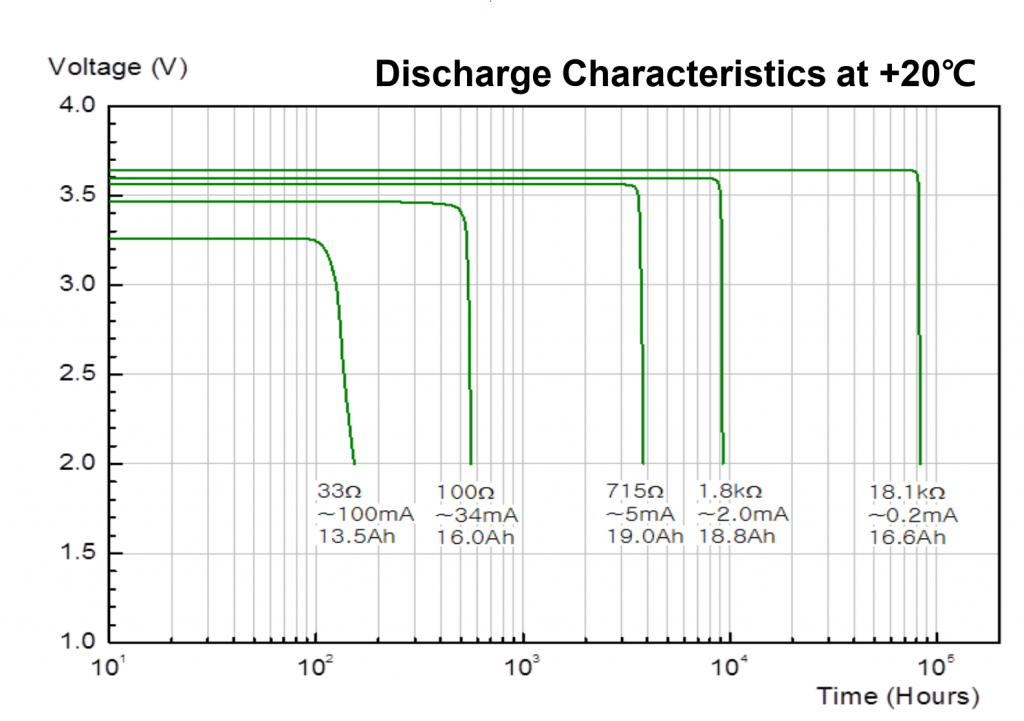ncd.io Battery Life Calculator
Note: These are theoretical calculations. Real-world battery life may vary based on transmission retries, RF noise, and environmental factors. Time domain data stream is counted as one packet.
⚠️ Why Battery Voltage Isn’t a Good Indicator of Life
Battery voltage may seem like an easy way to monitor battery life, but it’s extremely misleading for lithium batteries:
- Voltage stays flat between 3.3 V and 3.6 V for most of the battery's life
- Sudden drop: When the battery nears depletion, voltage plummets rapidly toward 2.0 V
- Load impact: Voltage drops temporarily under load, then recovers — giving false confidence
That means by the time voltage dips, it’s often already too late to act.
Better approach: Use a usage-based model like this calculator to estimate true battery life. It considers pulse current, frequency, temperature, and self-discharge — not just voltage.
One of the most common misconceptions in battery-powered systems is that you can accurately estimate battery life by simply monitoring voltage. While this seems intuitive, it’s deeply flawed — especially for modern lithium-based primary cells.
The Problem with Using Voltage
Let’s look at the discharge behavior of a typical Li-SOCl₂ battery, like the one in the chart you provided. At room temperature (+20 °C), the battery voltage:

For this Battery, we can use this formula to convert battery voltage into %
float percent = 100.0 * (1.0 – exp(-5.5 * (voltage – 2.5)));
percent = constrain(percent, 0.0, 100.0);
function voltageToPercent(voltage) {
const vMin = 2.5;
const vMax = 3.3;
if (voltage >= vMax) return 100;
if (voltage <= vMin) return 0;
const scale = 5.0; // tuning factor for steepness
const percent = 100 * (1 – Math.exp(-scale * (voltage – vMin)));
return Math.min(100, Math.max(0, percent));
}
Stays relatively flat between 3.3 V and 3.6 V for nearly 95% of its life, Drops very rapidly toward 2.0 V once the cell nears depletion. Exhibits an exponential plunge rather than a linear slope
So what’s the issue?
By the time voltage drops noticeably, the battery is already almost dead. The “cliff” happens so quickly that by the time your system detects a voltage drop, it might already be too late to act.
Other Factors That Make Voltage Unreliable
Load Dependence: Battery voltage varies with current draw. A 100 mA load can cause visible sag, while a 2 mA load might show no change.
Temperature Sensitivity: Voltage behaves differently in cold vs hot environments. Lower temps suppress voltage, even when capacity remains.
Recovery Effect: After a heavy load pulse, the voltage rebounds — tricking systems into thinking the battery is still “healthy”.
Better Alternatives to Monitor Battery Life
Coulomb Counting / Usage Modeling Track how much energy has been consumed, factoring in load profiles, pulse duration, frequency, and temperature.
Battery Life Calculators (like ours) Estimate life based on actual use patterns, self-discharge rates, and realistic pulse loads — instead of guessing from voltage.

